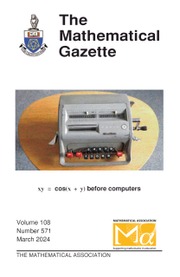No CrossRef data available.
Article contents
Some polygon area theorems
Published online by Cambridge University Press: 15 October 2025
Extract
Figure 1 shows an arbitrary triangle Z1Z2Z3, the base triangle, with similar isosceles triangles Z1Z2V1, Z2Z3V2 and Z3Z1V3 drawn outwards on the respective sides Z1Z2, Z2Z3 and Z3Z1, all with base angles (the angles at Z1, Z2 and Z3) equal to α. We call ΔV1V2V3 the outer α-triangle of ΔZ1Z2Z3. Note that, if ΔZ1Z2Z3 is positively oriented (that is, if the labels go around the triangle in anticlockwise order), then so is ΔV1V2V3, but the triangles Z1Z2V1, Z2Z3V2 and Z3Z1V3 are negatively oriented (that is, the labels go around the triangle in clockwise order).
Information
- Type
- Articles
- Information
- Copyright
- © The Authors, 2025 Published by Cambridge University Press on behalf of The Mathematical Association
References
Coxeter, H. S. M. and Greitzer, S. L., Geometry revisited, Mathematical Association of America (1967).CrossRefGoogle Scholar
Silvester, John R., Some triangle theorems by complex numbers, Math. Gaz. 107 (November 2023) pp. 454–473.10.1017/mag.2023.98CrossRefGoogle Scholar


